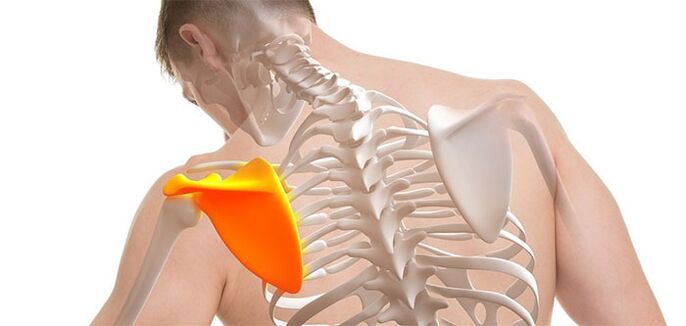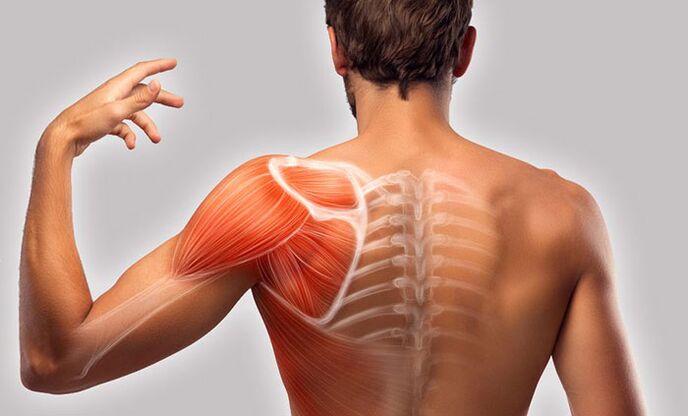Patients rarely pay due attention to recurring pain in the shoulder blade area. However, this symptom is a "wake-up call" of serious changes not only in the musculoskeletal system, but also in the internal organ-complex. Such conditions can threaten the patient with disability and death. How not to miss the disease and cure back pain in the shoulder blade area, read on.

Etiology
The spine is the main component of the human musculoskeletal system. Hence, the lion's share of pressure during static or dynamic falls on the spine. Therefore, it is not surprising that a common reason to see a doctor is pain in the shoulder blade area.
However, the pain syndrome is quite changeable: often the pain is provoked not by the spine itself, but by a violation of the functions of the internal organs. This fact makes it difficult to diagnose the root cause of the pain syndrome and leads to errors in treatment.
The main causes of pain include pathologies of the musculoskeletal system and the internal one.
The first group includes:
- osteochondrosis;
- spinal deformities;
- trauma and spondylolisthesis;
- spondylosis;
- osteoporosis;
- ankylosing spondylitis.
Of the non-vertebral causes, diseases of the internal organs are the most common (pneumonia, heart attack, intercostal neuralgia, gastric ulcer, cholecystitis). In addition, tumor processes or mental lability (fibromyalgia, psychogenic pain) can cause pain.
Pain changes
Why does the back hurt in the shoulder blade area? In general, the pain syndrome can be localized both directly in the area of the shoulder blades, and between them. The pain is bilateral (with scoliosis) or is located mainly on one side (gastric ulcer, cholecystitis).
By the nature of the back pain between the shoulder blades, it can be acute (occurs suddenly with a rapid increase in strength) or chronic (weak and prolonged). The main difference in practice is that the patient can accurately name the time of the onset of acute pain syndrome. Remembering the circumstances of the onset of chronic pain will be difficult.
Pathology options
A number of diseases can cause back pain in the shoulder blade area, but we will focus on the most common ones.
- Osteochondrosis.Osteochondrosis is a disorder during which the "aging" of the intervertebral disc occurs. In advanced cases, such pathological changes lead to a hernial disc protrusion. When the thoracic spine is affected by osteochondrosis, patients are concerned about severe back pain between the shoulder blades, which occurs when bending or staying in uncomfortable positions for long periods. It is possible to add tangible weakness of the back muscles, disturbances in the perception of temperature and pain.
- Spinal deformities.One of the causes of pain between and in the shoulder blade area is the curvature of the spine. As a rule, the pain causes kyphosis (curvature, hump) or scoliosis (spine in the shape of a C, S, or Z). With significant deformities of the spine, aching pain appears, aggravated by physical activity. Episodes of respiratory failure (shortness of breath, inability to "breathe deeply") are frequent. The clinic is also accompanied by increased fatigue and headache. In rare cases, the chest is bent.
- injuries.Acute pain often appears with direct trauma to the spine or the shoulder blades themselves. Similar injuries occur in the event of a fall from a height, collision with a blunt object, transport, or workplace accidents. Spinal injuries are associated with palpable pain, reflex contraction of the back muscles, and bruising. In some cases, attachment of neurological pathology is possible. When the shoulder blade is traumatized, the pain is acute, aggravated by the swing of the arms. Sometimes it is combined with hemorrhages in the cavity of the shoulder joint - hemarthrosis.
- Spondylosis.Spondylosis is called senile destructive processes in the spine. Usually, in the area of the intervertebral joints, bone tissue grows - osteophytes are formed, which can be complicated by the augmentation of the vertebrae between them. In such cases, severe pain, neurological and vascular disorders appear.
- Osteoporosis.Osteoporosis is a disease associated with a decrease in the density of the bone system. Usually, back pain in the shoulder blade area occurs when a fracture of the thinned thoracic vertebrae occurs. Curvature of posture appears - the formation of scoliosis and / or kyphosis. In some cases, the disease is complicated by radicular syndrome (disappearance of motor activity and sensitivity).
- Ankylosing spondylitis. . . Ankylosing spondylitis is a disease that affects the intervertebral joints. Usually, the clinic begins with pain between the shoulder blades or in the lower back. The pain is accompanied by stiffness of movements, which intensifies after a night's rest. With the development of pathology, the spine is deformed, arched, which leads to curvature of the chest and respiratory failure. In such a pathological position, ankylosis (immobilization) of the intervertebral joints occurs, as a result of which the patient can no longer bend. In this case, the disorder can also affect the cardiovascular and urinary systems.
- Diseases of the internal organs.With pneumonia (inflammation of the lungs), a detailed clinical picture is characterized by fever, sputum production and one-sided pain in the chest or back in the shoulder blade area. During a heart attack, the pain is sharp (stabbing, burning), is determined in the chest and radiates to the left shoulder blade and upper limb. Pain syndrome with intercostal neuralgia is acute and penetrating, manifests itself in the form of attacks that interfere with the patient's breathing. Pain occurs along the ribs, is distributed under the shoulder blades, collarbone and lower back. With a stomach ulcer, the pain is dull, localized in the upper abdomen, often accompanied by "hungry" pains (with long pauses between meals). In this case, the ailment is characterized by digestive disorders, nausea, vomiting and acid belching. Sometimes there is bleeding from the ulcer: patients feel a dagger pain, which disappears at the height of the hemorrhage. Vomit and stool become dark in color (almost black) due to impurities in the blood. Cholecystitis (inflammation of the gallbladder) is characterized by the occurrence of a characteristic paroxysmal pain syndrome in the right hypochondrium, spreading to the right side and shoulder blade. The clinic of the disease includes digestive disorders, the provoking factor of which is the consumption of fatty and fried foods. Sometimes vomiting appears with bile impurities.
- Tumors.Pain in the shoulder blade area may appear with neoplastic diseases of the vertebrae or nerve sheath (neuroma). Metastases (daughter tumors) from the prostate or affected mammary glands can spread to the vertebral region. In this case, the tumor process is characterized by an asymptomatic course, and the appearance of pain is associated with an increase in the neoplasm and its pressure on the neurovascular bundle. Cancer may be suspected of "watchdog symptoms": pain, weight loss, fever, and constant weakness for no apparent reason.
- Mental lability.Instability of the psyche to stress and emotional outbursts can manifest itself as psychogenic pain. It arises against the background of complete health: patients can experience sensations of various strengths that cannot be treated even with painkillers. Stressful situations also cause another idiopathic (causeless) pain: fibromyalgia. The disease proceeds against the background of prolonged pain sensations, intensifying at certain points (triggers).
Diagnostics
Radiography is the gold standard for examining the spine. Computed tomography can be used to determine the cause of spinal pain. To study other organs and systems, ultrasound diagnostics or MRI are used. To exclude concomitant pathologies, laboratory examination methods or other instrumental methods may be required.
Treatment
These pathological conditions require a specific treatment plan, only a doctor can prescribe drugs.
- Osteochondrosis.As drug therapy for pain relief, non-steroidal anti-inflammatory drugs and analgesics are used. Physiotherapy, remedial gymnastics, and massage are also effective. In the later stages of the disease, surgery is recommended to remove the hernial sac.
- Spinal deformities.Conservative therapy for spinal curvature consists in the use of supportive devices (corsets, bandages). You also need sufficient activity, massage and physiotherapy (paraffin applications, electrical stimulation). In case of significant deformity, surgical methods of treatment are indicated to fix the spine in the anatomically correct position.
- injuries.Minor injuries are treated with rest, heat, and massage; more severe injuries may require traction. If conservative methods are ineffective, the spine is reconstructed with an operative method.
- Spondylosis.Treatment of this pathology is aimed at slowing the progression of the disease. Then, injections of hyaluronic acid, chondroprotector, physiotherapy (shock wave therapy) and physiotherapy exercises are prescribed. With severe pain syndrome, blockade is performed with painkillers.
- Osteoporosis.Treatment of osteoporosis includes a high dosage of calcium and vitamin D supplements. Hormone therapy with female sex hormones, thyroid and other hormones is also possible.
- Ankylosing spondylitis.Inflammation and pain are controlled by anti-inflammatory therapy. To change the immune response, an antimetabolite from the group of structural analogues of folic acid is prescribed. Physiotherapy, breathing exercises and therapeutic massages are performed during remission.
- Diseases of the internal organs.Pneumonia therapy includes antibacterial agents and medications that relieve bronchospasm. During the rehabilitation period, vibrating massages and therapeutic exercises are prescribed. Intercostal neuralgia is treated with warming and anti-inflammatory ointments. Distraction therapy with topical remedies with chili extract or bee venom is often used. Treatment of gastric ulcers consists of combined antibiotic therapy and drugs that reduce the acidity of the gastric contents. Help with cholecystitis includes the use of antispasmodics and drugs that affect bile. In some cases, antibiotic therapy may be required. In the presence of large stones in the gallbladder, it is recommended to remove the latter - cholecystectomy.
- Tumors.Treatment of tumor processes consists of chemotherapy with antineoplastic agents and surgical removal (if possible) of the neoplasm.
- Mental lability.Mental lability requires intensive psychotherapy, as well as the use of antidepressants or anxiolytics. Limiting psycho-emotional stress is an important part of treatment.

How to prevent?
To prevent back pain in the shoulder blade area, lifestyle changes are necessary: increasing the nutritional value of the diet, playing sports, quitting smoking and drinking. It is important to detect and treat chronic diseases early to avoid stress overload.
Remember, pain is not an independent ailment, but a manifestation of a much more serious pathology that requires proper diagnosis and treatment!


























